Kiznaiver and Mayoiga: Okada Mari in Spring 2016
April 17, 2016 11 Comments
 |
|
| Nagai Tatsuyuki and Okada Mari talking about The Anthem of the Heart (source) | |
When I declared two weeks ago that I’d be looking at Okada Mari for this next post in my ‘Anime Writing’ project, I hadn’t actually read more than one of her interviews (the noitaminA one that’s summarised with one mistake here).1 Just one week later, I found myself regretting that rash decision, for I’d come across around ten relevant interviews, and had no idea if I’d even be able to put together something coherent. In the end, I decided that the best thing to do was to focus on the offerings this season that she’s had a hand in: Kiznaiver and The Lost Village (Mayoiga).
Edit (2016-07-05): I’ve recently noticed anime fans talking about what I’ve translated here in a slightly out-of-context manner. Please note: these are just smallish parts of the two interviews in question. The Kiznaiver interview is four times longer, and the Mayoiga interview is actually around 8,000 words in total. I only translated the sections that were relevant to the theme of my post: “what part did Okada Mari play in the genesis of these two series?” so please keep that in mind. -karice
Okada and Kiznaiver
So, to start this off, here’s part of an interview that was published in the November 2015 edition of PASH!, and which was made available online sometime this year.2 In it, series composer Okada Mari and producer Ōtsuka Masahiko talk about how they came up with the idea behind Kiznaiver, and share a few details about where the show is heading.
—To start off, can you tell us how you came to make this original anime, Kiznaiver?
Ōtsuka: In 2012, Trigger was involved in the production of Black Rock Shooter (BRS), so I worked alongside Okada (Mari) then. Because I’d always found the stories written by her to be rather interesting, I mentioned within the company that I’d like for us to do something with her. So our producer, Tsutsumi Shōko, approached Okada, who was completely on board with it. At first, we discussed a lot of different ideas proposed by various people, before Okada proposed the idea of Kiznaiver.
Okada: It was the two of us together with Trigger’s Imaishi Hiroyuki3 and Tsutsumi—we had some really interesting discussions. All of us just kept throwing out ideas that we would then talk about, with no restrictions on genre. If I remember, your proposal was for a special attack/kamikaze squad?
Ōtsuka: Yeah, it was (laughs). And you also came up with something about hell/the underworld.
Okada: It was a pretty popular theme at that time, after all (laughs). Though that idea was put aside with a “well, let’s do that sometime.”
Ōtsuka: And finally, we decided on this one. About three years ago, right? At that time, Aniplex wasn’t on board yet, so we were like “Let’s put this proposal together and go get some funding!” That kind of project genesis, where we’re planning something from some pretty vague ideas, is pretty rare. Trigger was only about a year old at that stage, so there was an atmosphere of “Let’s do all kinds of things!” We were in the middle of developing Kill la Kill at that point, so we hadn’t actually done an original yet. But that’s also why we didn’t wait until the time was ripe or get over-enthusiastic, but just slowly and steadily got going on it.
Okada: And we put it on hold at one point, too—it was only after Kill la Kill had aired that we started it up again, sometime in 2014.
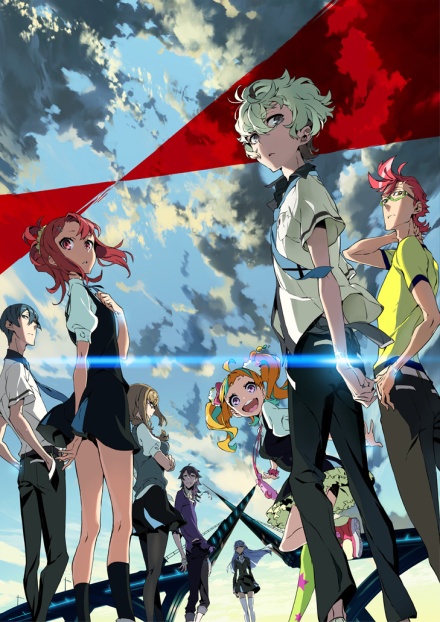 |
So, it’s pretty obvious that Okada was involved right from the start in developing Kiznaiver (that’s why she and Trigger are credited for coming up with the ‘original work’ (原作). In another interview, however, director Kobayashi Hiroshi reveals that he was the one who proposed that focus on the (eight) main characters, instead of the ‘battle anime’ that it was when he was brought on board. But enough on Kiznaiver for the moment—you can read a summary of the other stuff they talk about here—let’s turn now to the other Okada original that’s airing in Spring 2016: The Lost Village (Mayoiga).
Okada and The Lost Village
The following comes from an interview with Pony Canyon producer, Ishiguro Tatsuya, diomedea president Kohara Makoto and Nakayama Ryōtarō, president and Cyber Agent of crowdfunding company Makuake. In it, they talk mostly about why and how they decided to use crowdfunding to help publicise The Lost Village; however, near the start, they also talk about how the series came into being.
—So the timing was right. And this is from Kohara. The two of you (Kohara and Ishiguro) talked about wanting to do an original series.
Kohara: We first started talking about it in the second half of 2012 or thereabouts, about doing an anime original. But this is something that our production company hadn’t done before, so I didn’t know how to go about planning it. Of course, we’ve been fortunate enough to be approached about making adaptations, so if we didn’t have the courage and the opportunity to do an original, then it would never have come about. So we had luck on our side too. But we needed to have the desire to do it. Personally, I wanted to do something dramatic. A show that’s classified as a drama, but where the story isn’t episodic—instead, it’s something that builds gradually with each episode. I wanted to depict a drama about people, about their feelings and their relationships with each other. Around that time, I met (for the second time) Producer Ishiguro who was working on Ikamusume [Squid Girl], and we got along really well. So I figured that I’d consult him about it. Because we had similar interests in terms of drama, we were quickly in one mind about this. The first time we’d met was actually in 2005-6, in relation to WOWOW’s Hanbun no Tsuki ga Noboru Sora [Looking Up at the Half-Moon], which also focused on human drama. We’d met as animator and producer back then, so we felt that it was something like fate and decided “Let’s make something good!” And then, as the first step, we starting thinking about who we should ask to direct.
So you decided on the director then?
Kohara: Yes. Director Mizushima was working with Ishiguro on Ikamusume, and so we arranged to meet to see what we could do. But because he is so busy, he said that even if he did take it on, he didn’t know when he’d be able to do it.
Ishiguro: He’s quite in demand, after all.
Kohara: But in the end, he was our first choice, so I really wanted to ask him to take it on, so I contacted him again. And he said that he’d be able to do it in 2016.
—When was that?
Kohara: Back in the second half of 2012. And I said, “So about three years from now, then?” For Ishiguro too, in terms of planning out productions for his own company, it was pretty rough to plan all the way out to 2016 so early. We originally thought that we could aim for 2014-2015.
Ishiguro: I remember that, too.
Kohara: Right? But we got pretty enthusiastic about it, and Mizushima had agreed. So we started discussing it, and I suggested that we look at urban legends, whilst Ishiguro brought up the idea of Japanese demons (youkai).
Ishiguro: I’d always wanted to do a Japanese fantasy of some sort.
Kohara: With that idea of doing a Japanese fantasy on the table, Mizushima said “Then how about we combine these?” And in discussing all that, we ended up bringing the human/people side in. And whilst we were discussing all of this, the director said that he wanted to have a lot of characters. And we realised that “this will be impossible without a dedicated series composer,” so we got to talking about who we should ask to take on that role, and I said “With what we’ve been discussing, what about Okada Mari?”
Nakayama: That was a name that I also knew.
—Those names you’ve just thrown out, Director Mizushima and Scriptwriter Okada, are behind many current hit anime, so putting them together would get a lot of tongues wagging. Was that something you were aiming for?
Kohara: Not per se, but it’s something I came to as we went about planning this. And then there was also the thought that “If Mizushima and Okada did something together, it’d be pretty interesting, right?” So I said to Ishiguro: “Let’s just go with Okada.”
Ishiguro: At that time, we discussed how there are three pillars we need to get during the planning stages in order to come up not only with funding but also the content. The director, the series composer and the character designer. Of these three pillars, at least two of them have to be major names if we want to do an original.
Kohara: It’s pretty rough.
Ishiguro: When you’re talking about adapting an existing work, there are many ways to go about planning for it. But we were talking about an original. To set up a production committee, you need to explain it to each company and get them to participate in the planning process. But on top of that, if two of the three pillars aren’t big movers, then it’s pretty difficult to get the green light.
Kohara: And it so happened that both of them had worked with diomedea before.
[Snip]
Kohara: I was glad that I had met the two of them before. And it’s not that we decided everything and got them to do the cooking, it’s more like we all came together to work on the same ingredients.
—So it was like fate had already connected all of you, and as the two of you talked about wanting to make this work, their names came up.
Kohara: Okada also got on board pretty quickly, with a “Sounds good, seems pretty interesting to me.” And Mizushima also said that he wanted to work with her, so the four of us started feeling the whole thing out together. After that, we added a character designer and went about making the story together, and what we got was this champloo4 of Japanese fantasy, human dramas and urban legends all mixed together.
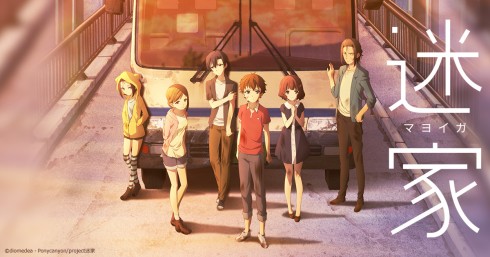 |
Thus, in the case of The Lost Village, we can see that Okada joined a fair bit later than with Kiznaiver―after the major concepts had been decided. In the third part of this crowdfunding interview, there is another short discussion about what happened as these five core people went about developing the story together. Basically, more than usual, the path forward was quite unclear. They knew where they wanted to end up, but weren’t completely sure how they should get there, especially in terms of how particular character arcs would tie in with that endpoint. For example, they even got to working on (the script?) for episode 10, and realised that they had to return to change something in the first episode.
You’re probably going to think “Uh-oh. Clear sign that this show’s writing is going to be pretty messy.” To be honest, I think it might too, though I’m probably not going to stick around to find out since there are too many other shows I’m more interested in. But the main take home for me is that even if the overall story does turn out to be a little messy, that blame would not lie with Okada alone.
What, then, does Okada actually do?
Okada is something of a hot topic at the moment. In fact, just over the last few days, at least two other bloggers have come out with posts about her history in the anime medium. I was especially impressed by the effort that both of them put into their research, one in terms of further reading and one in terms of media analysis. The latter, in particular, offers pretty comprehensive analyses of similarities that viewers might discern just from watching the shows she’s worked on. That said, I still found myself wondering whether they had underestimated the impact of the people that Okada worked with, for they both attribute to her aspects of anime ‘writing’ that I do not believe can be credited to her alone.
From these two interview snippets I translated above, we can see how Kiznaiver and The Lost Village got up and running and where Okada joined in. In the case of the former, the concept came from Okada who was involved right from the start, whilst she only joined later in the case of the latter. In both cases, however, she was involved as just one member of the core team developing the stories. And this is the pattern for most if not all of the other shows she’s been involved with. AnoHana is the only other original anime where I know that she came up with the concept. With regards to the other series that I’ve found interviews for, the True Tears and Hanasaku Iroha anime were proposed by P.A. Works producer Kenji Horikawa, whilst NagiAsu came from Takayuki Nagatani. WIXOSS I’m less clear on, but it seems to have been proposed by TCG (TakaraTomy Card Group) in order to promote the card game it had developed and published. After coming up with these ideas, they then asked the various directors and Okada to help them bring their ideas to the screen. As for adaptations, the only one I’ve really read about so far is Wandering Son [Hourou Musuko], and there, Director Aoki Ei was the one who decided that it’d be best to do the middle-school arc with Shuuichi coming to school in the girl’s uniform as the climatic focus of the story.
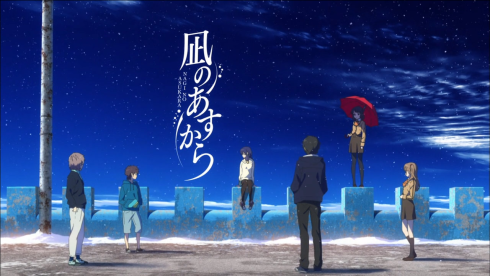 |
So what is Okada actually responsible for in the anime she works on? Generally speaking, the most important task that she works on alone are the details of what each project’s core team agrees should be in each episode—i.e. the dialogue and the representation of the emotions of each character—which she weaves into the scripts. When she’s series composer, she should be making sure that the show has the required story ‘beats’ spaced over the episodes the team has to work with, though it’s up to the series director/showrunner to take on the suggestions or not. She’d also be responsible for coming up with linking scenes, and little details that help make all the episodes seem like part of a coherent work, which she puts into the drafts of the script that she’ll discuss with at least the series director. But the director and storyboarder(s) of each episode—who do their work based on her script—can and probably do contribute to these little details, as prominent anime journalist Oguro Yūichirō pointed out in this column several years ago.
Hence, even in the case of Okada Mari, it is almost impossible to tell exactly who did what in terms of anime ‘writing’ unless one of the core staff talks about it. Many of the people that Okada works with praise her for the dialogue she writes, so I do assume that she is responsible for much of it. But if you actually want to know for certain who wrote a notable line, or who proposed a particular scene or character story arc, you can only hope that someone translates an interview that reveals the answer. Otherwise, the only other option you have is to try and ask Okada or the other creators yourself—good luck with that!
As always, these translations are my own, as are any mistakes or misinterpretations I might have made―if you spot any, do let me know and I’l address them as soon as I can. Other than that, please do not copy and paste the translations elsewhere, though feel free to link to them if you wish. -karice
- The summary says that Okada’s method is to be “intentionally vague. If you give the animators every single detail, she explains, it’ll constrain their creativity.” That’s actually something she was told. Her own philosophy is the next part: make them think that “this is something I’d like to try to draw,” but she says nothing about it being better to “give them something open enough” that that’s what they’d think. Instead, she seems to be implying that she likes to write the script in a way that makes them excited to animate the scene, to write the kind of scene that they want to draw more of in the future. ↩
- Accessed on April 10, 2016. ↩
- director of Gurren Lagann and Kill la Kill. ↩
- This comes from the Okinawan word for ‘stir-fry’—I took the romanisation from Samurai Champloo, which some anime fans should still be familiar with… ↩
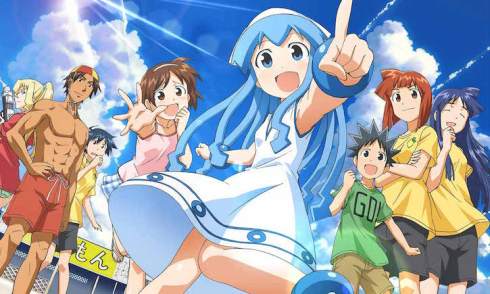
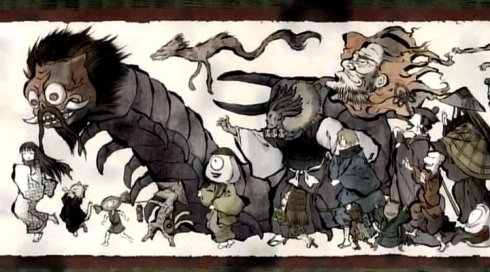
“Okada works with praise her for the dialogue she writes, so I do assume that she is responsible for much of it”
So it would be safe to say that she’s responsible for much of the show’s gobbledygook dialogue? Guess we can all go back to shitposting about the show as normal.
LikeLike
My personal impression is that Okada and co. were aiming for dialogue that would make you cringe. So if that’s what people are ‘shitposting’ about, then it’d serve as evidence that they’ve succeeded in that aim, at least.
LikeLiked by 1 person
Pingback: The Writing of Okada Mari | Mezashite! Fansubs
Pingback: Funomenal Overview: Anime Half-season Spring 2016 – Part I – ATMA & Funomena
Pingback: Mayo-Mayoiga, Qu’es-tu Mayoiga ? – Chronique de la folie généralisée | Yoster Avenue
Pingback: Anikenkai Anime Club 017 – O Clube dos Cinco Kiznaivers | Podflix
Pingback: Masterpost: On Anime ‘Writing’ Project | HOT CHOCOLATE IN A BOWL
Pingback: Mari Okada: Modes of Melodrama (Introduction) – Minute Art
Pingback: The Pre-Production of Anime #1: Planning – Sakuga Blog
Pingback: Introducing Kids Comedy Anime's Most Successful Screenwriter – Ang Kwan | | Ang Kwan
Pingback: Mayoiga (The Lost Village) - Se vira nos trinta… e tantos - Portal Genkidama